Abstract
In vitro cultivation of Treponema pallidum would facilitate many different aspects of syphilis research. This review summarizes developments in this field that have been published since 1975. Findings are discussed in terms of treponemes and the oxygen question, treponemal metabolism involving proteins, nucleic acids, and fatty acids, and treponemal interaction with tissue culture cells. Suggested future approaches and potential problem areas pertinent to successful cultivation are discussed.
Full text
PDF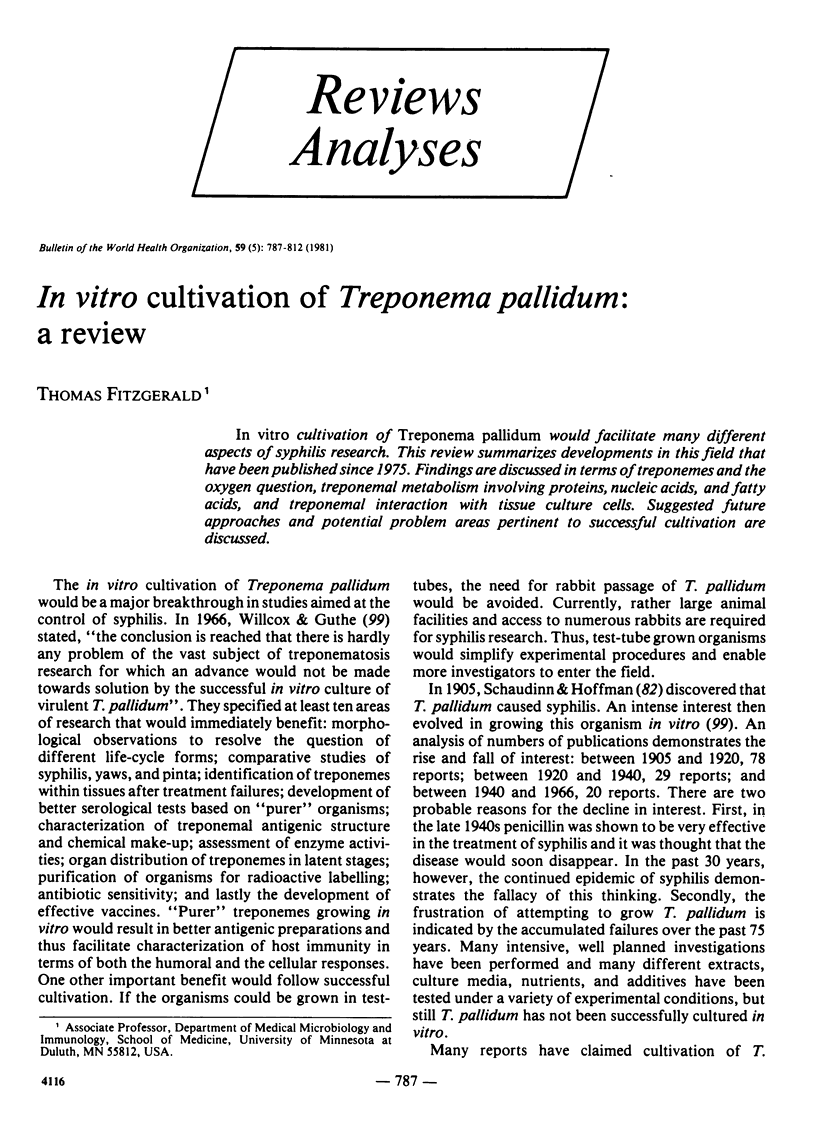
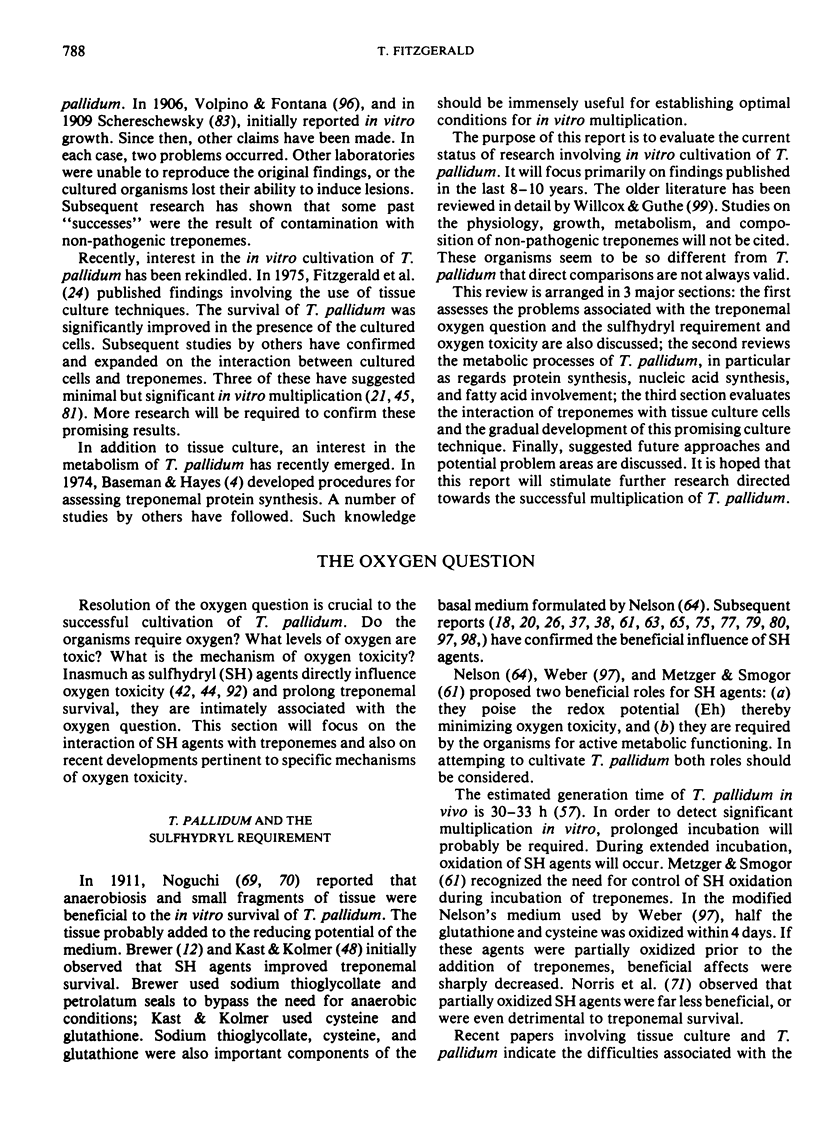
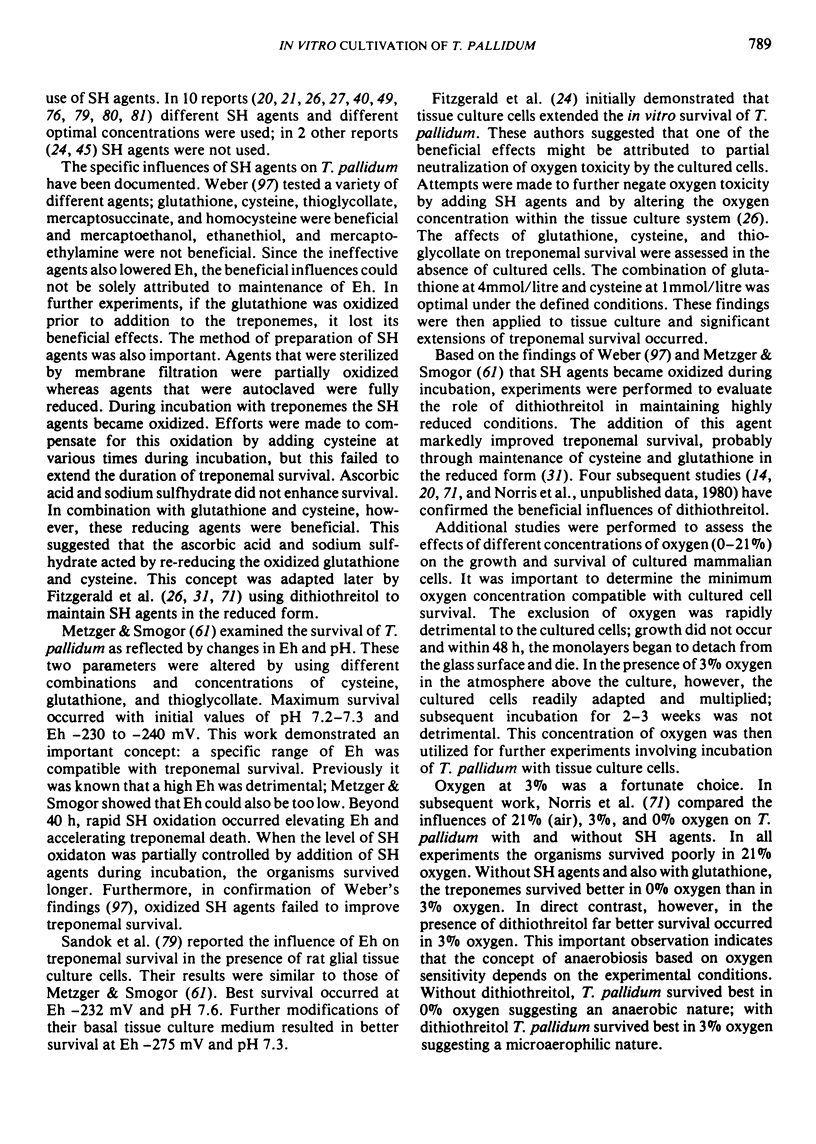
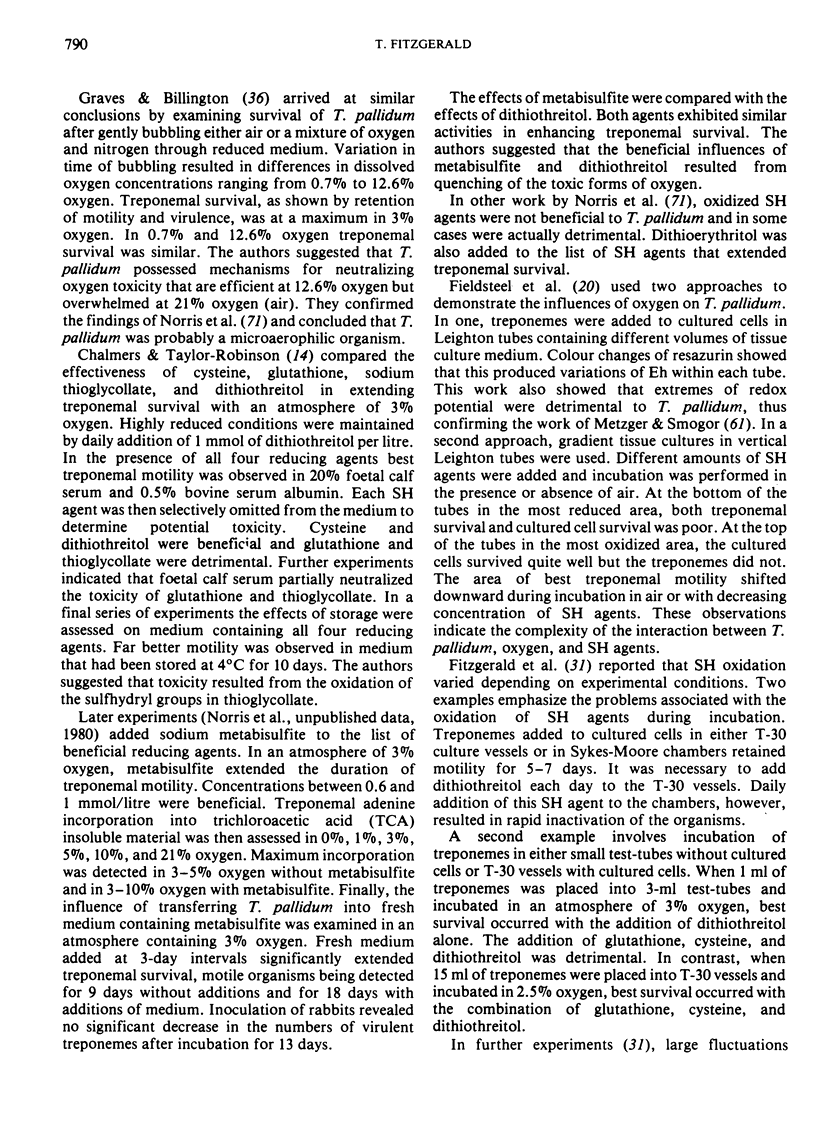
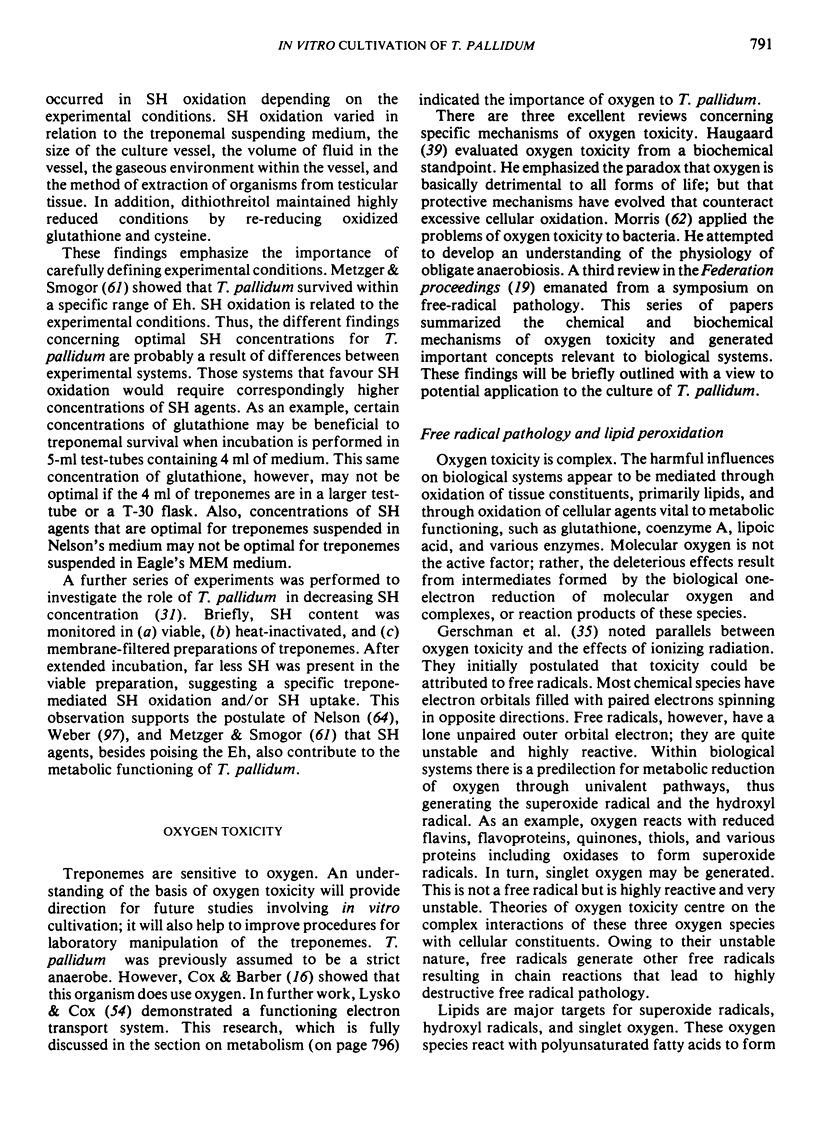
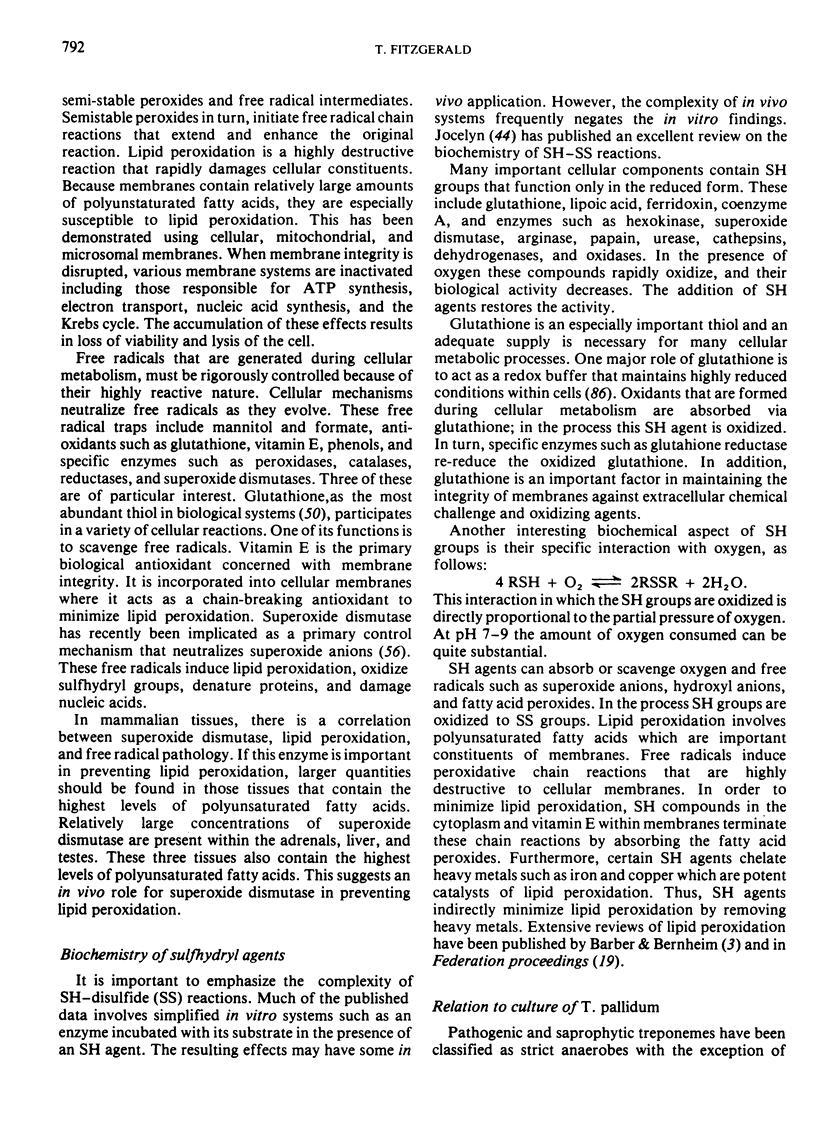
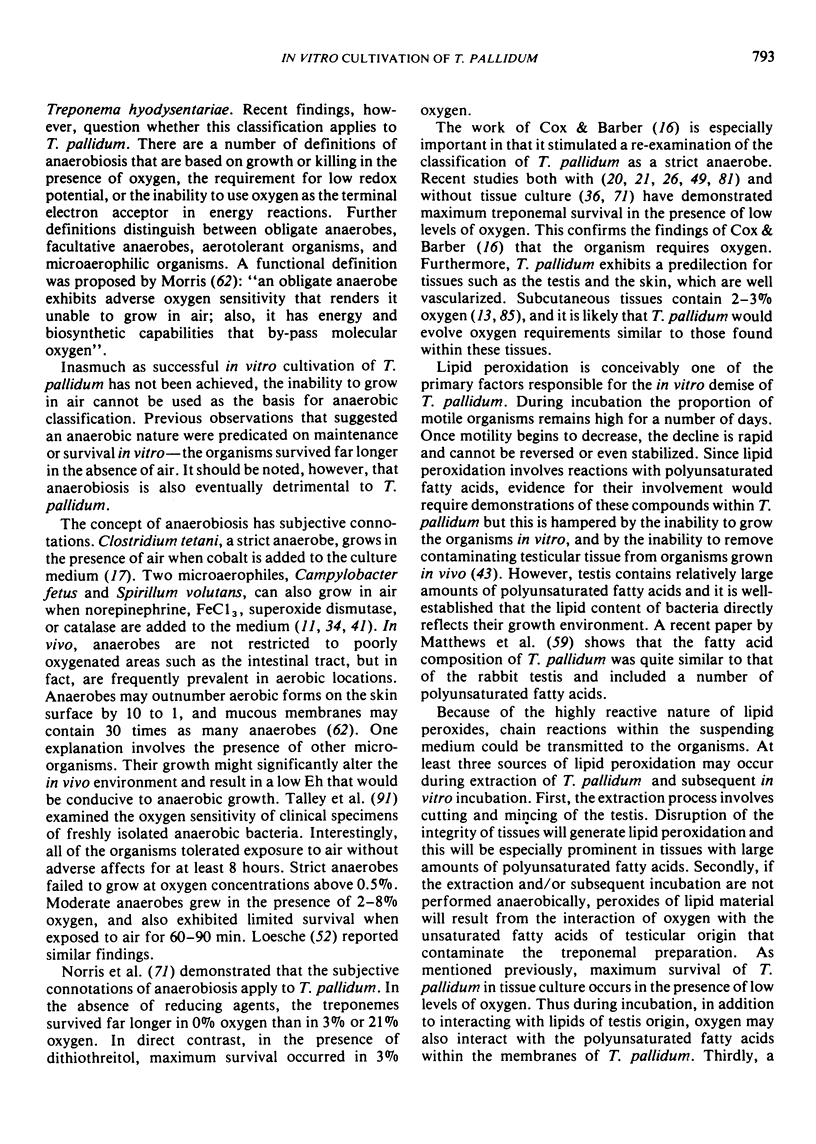
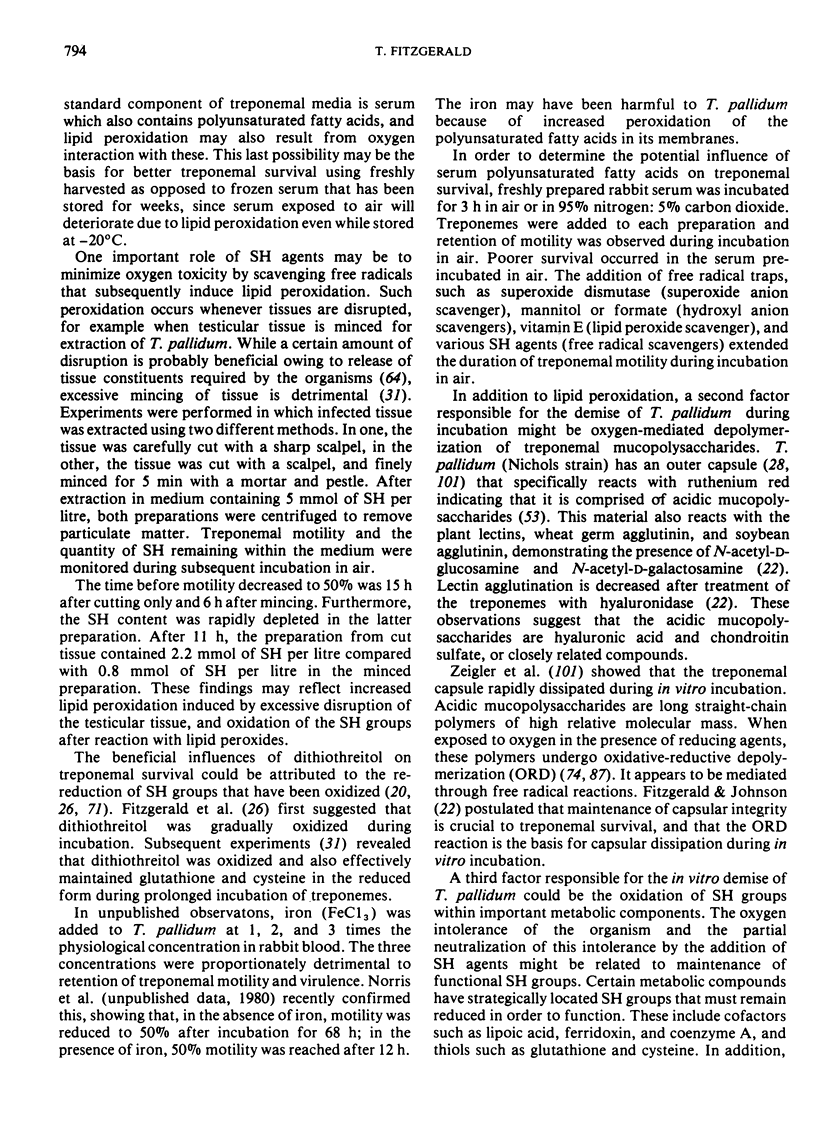
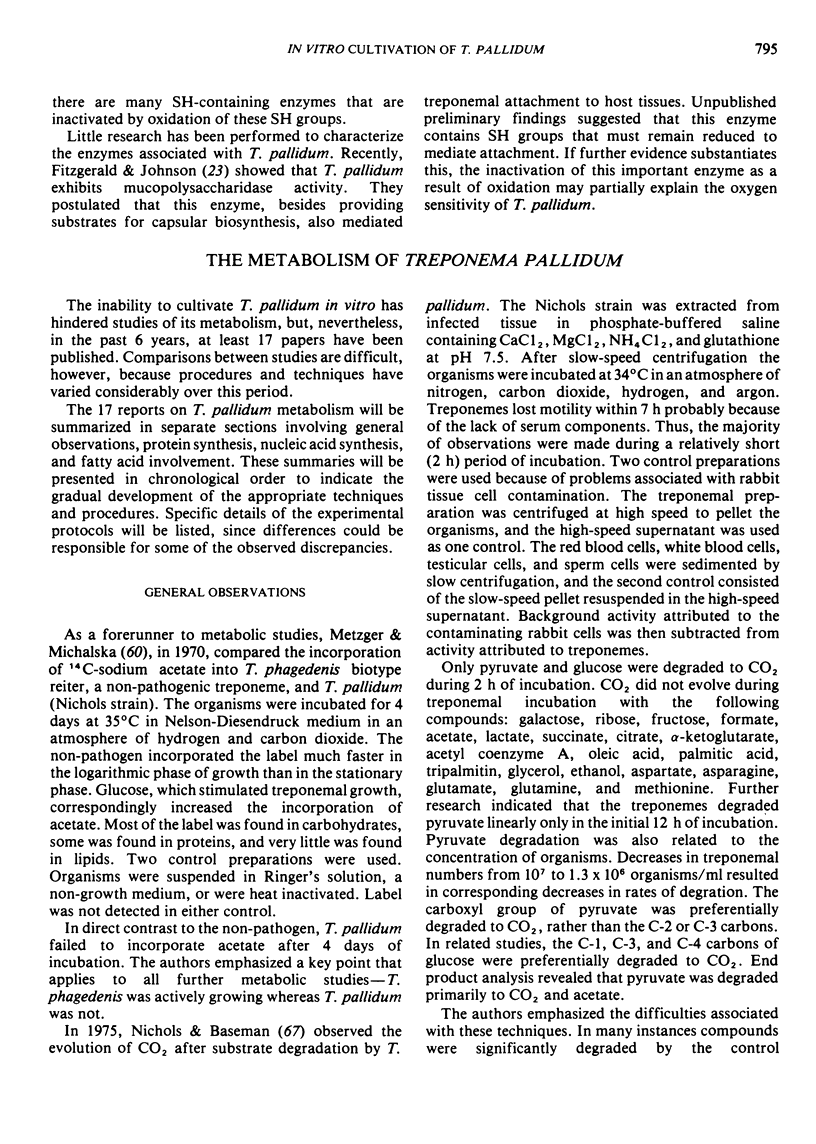
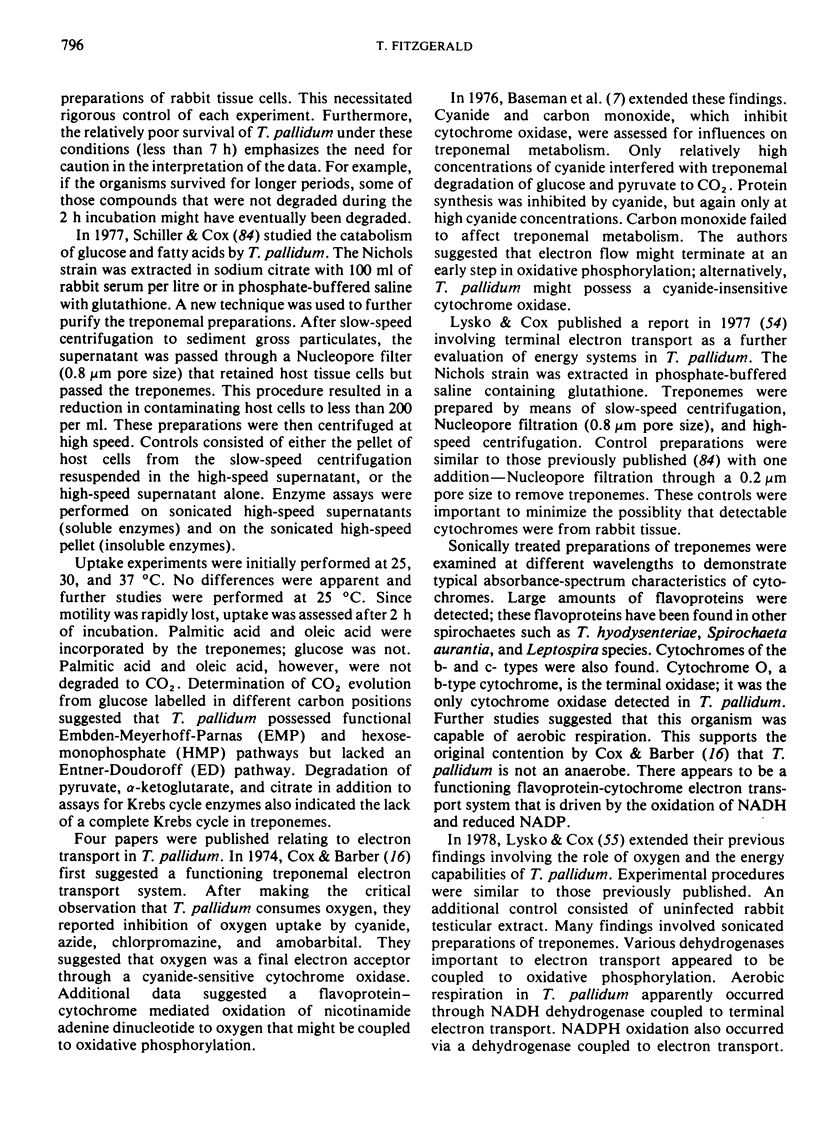
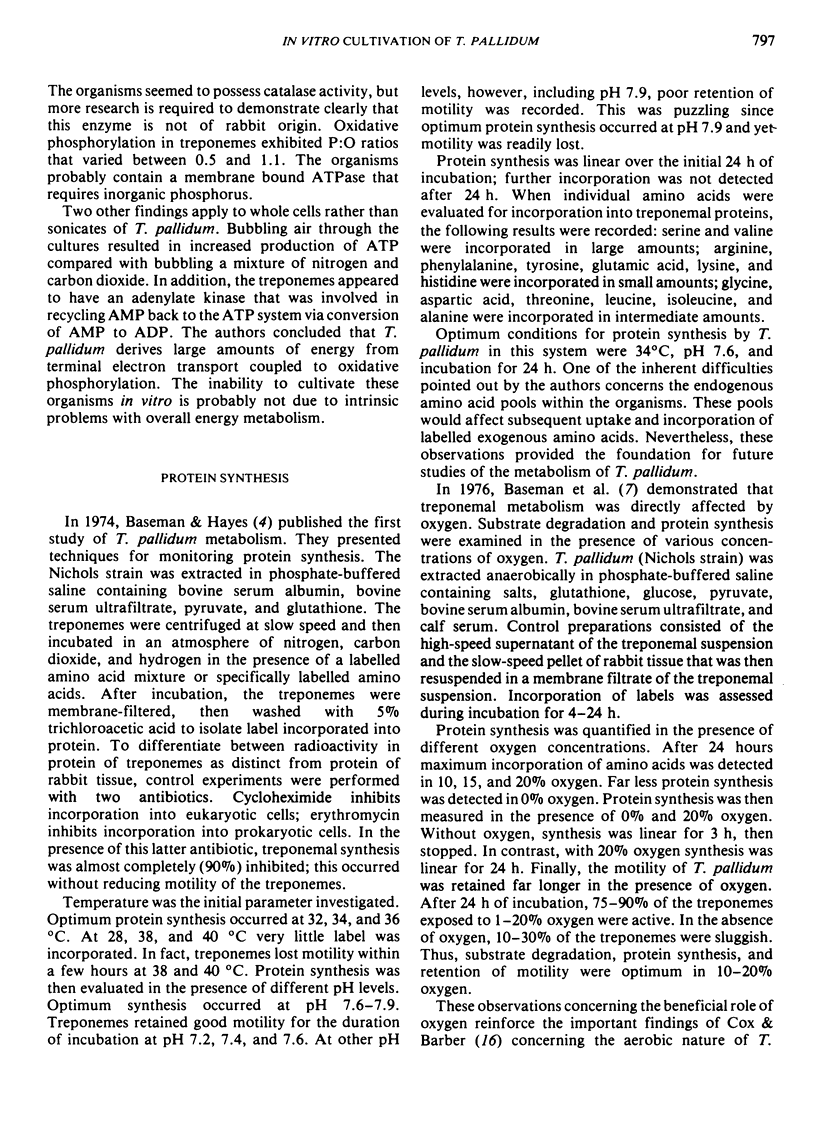
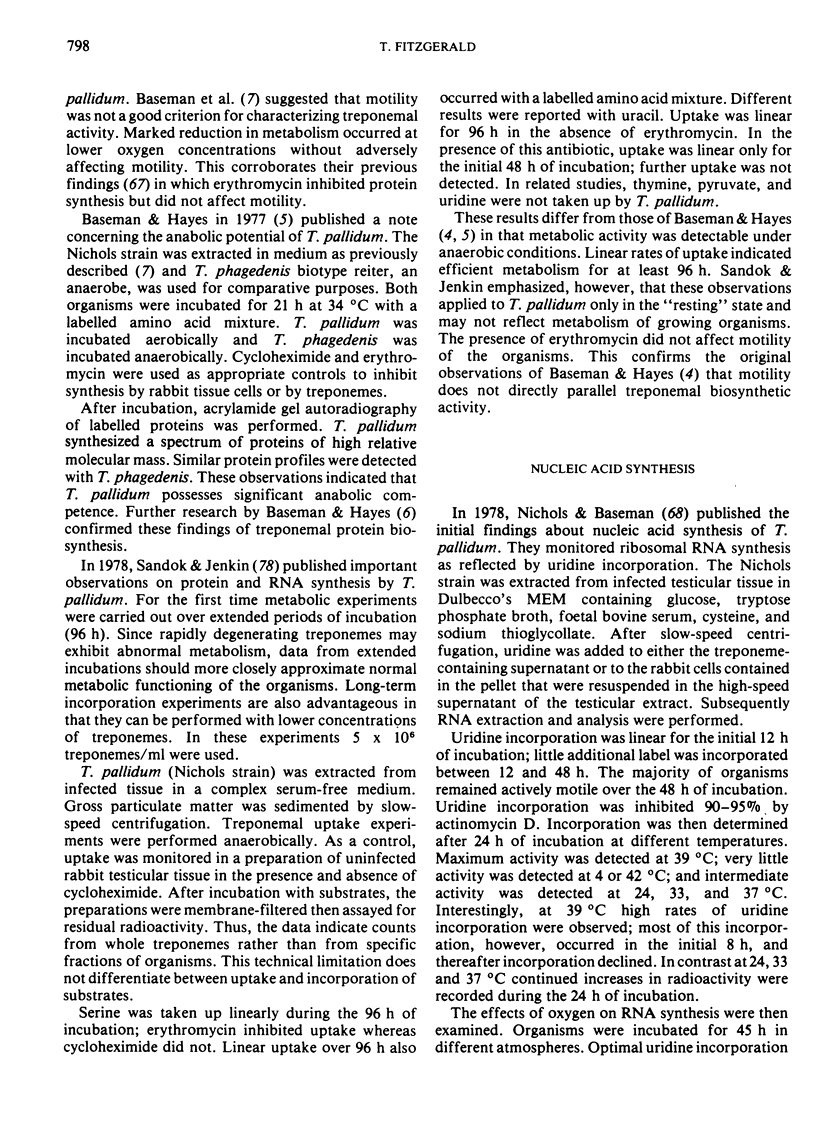

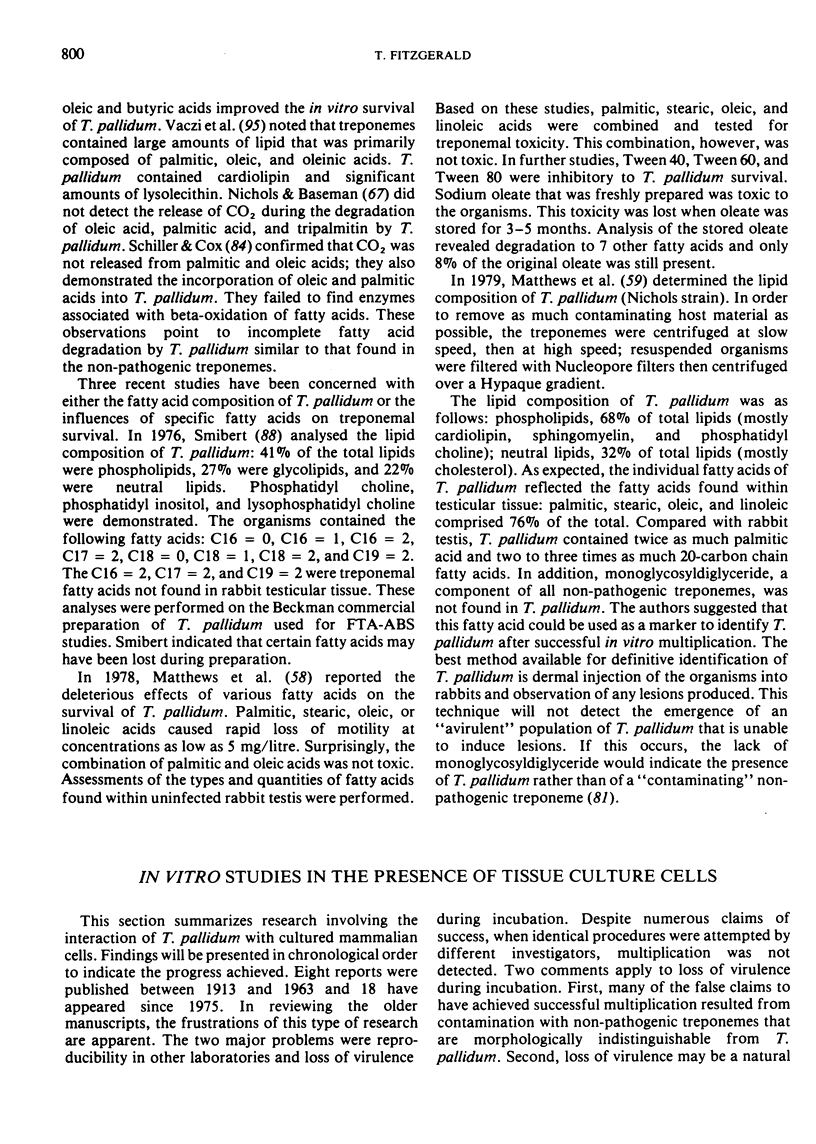
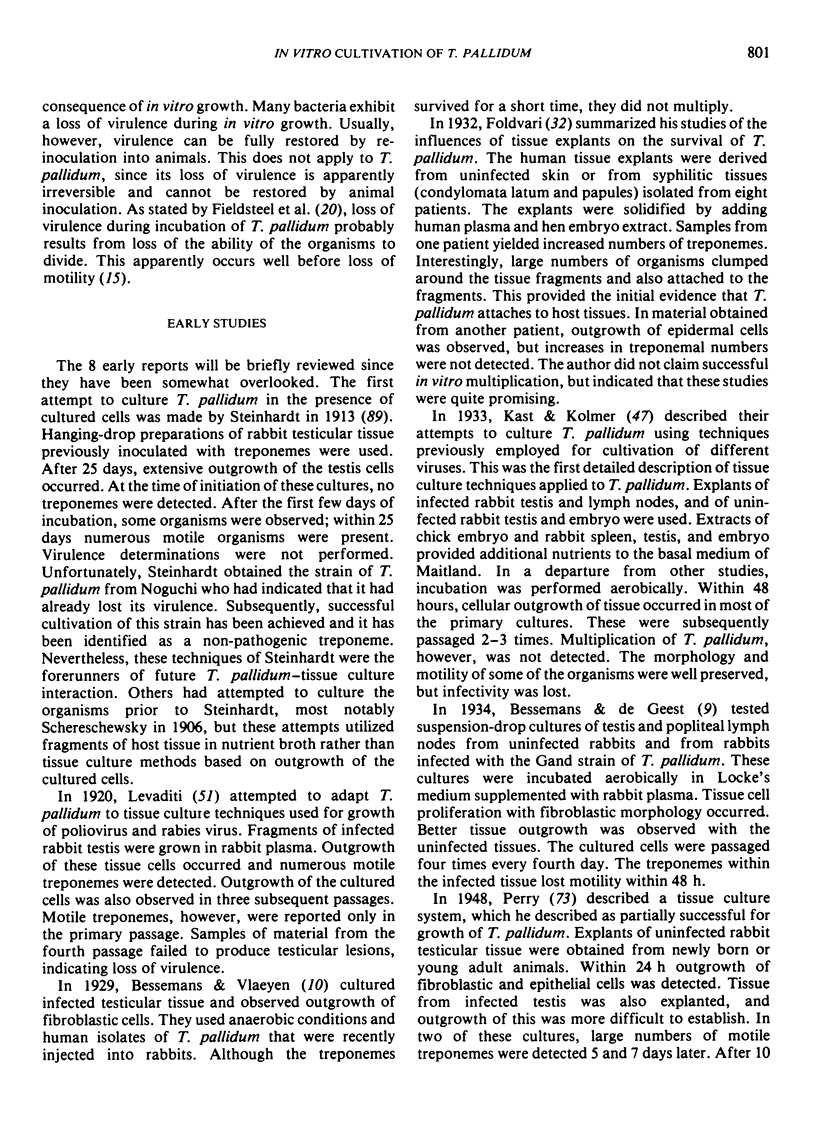
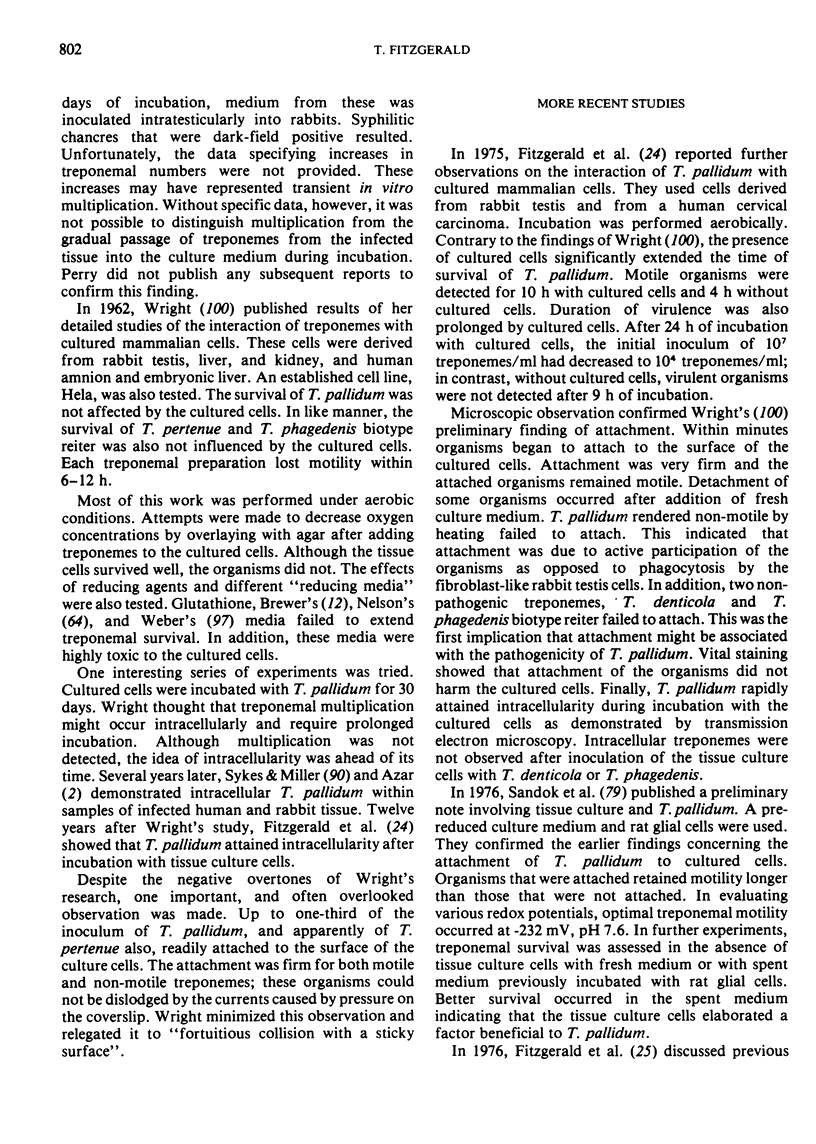
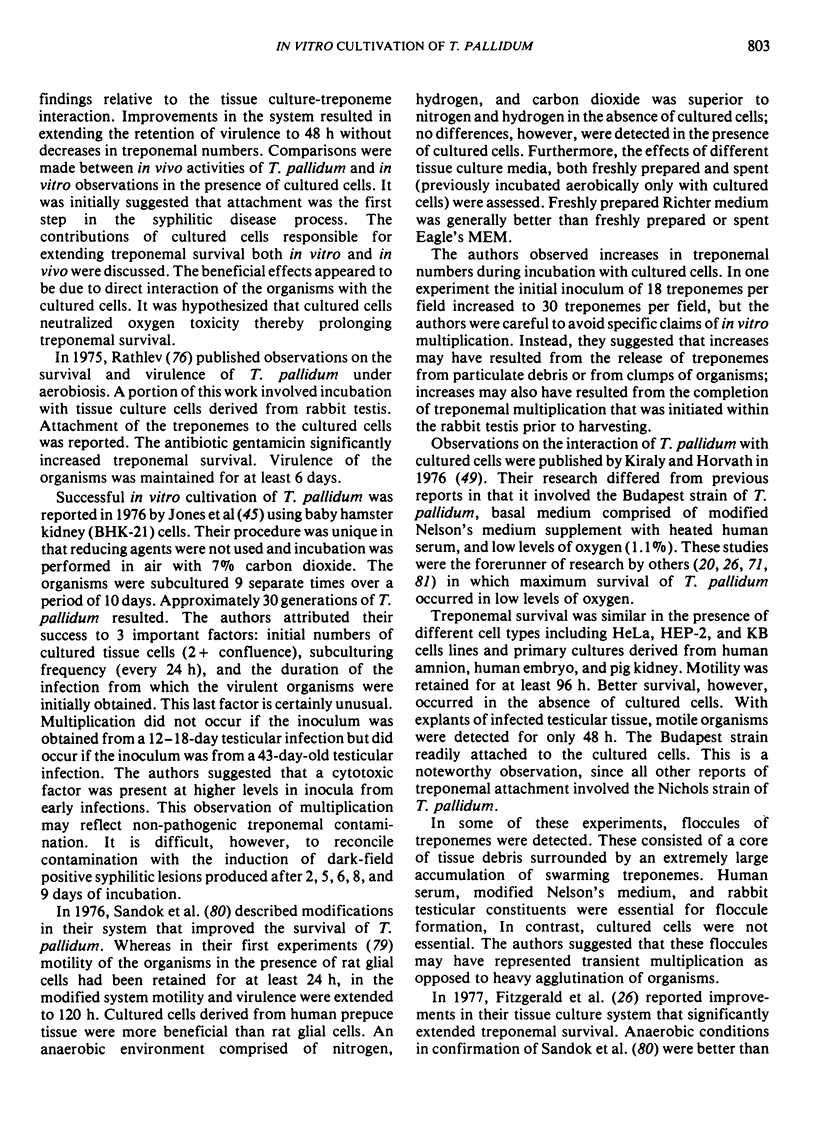
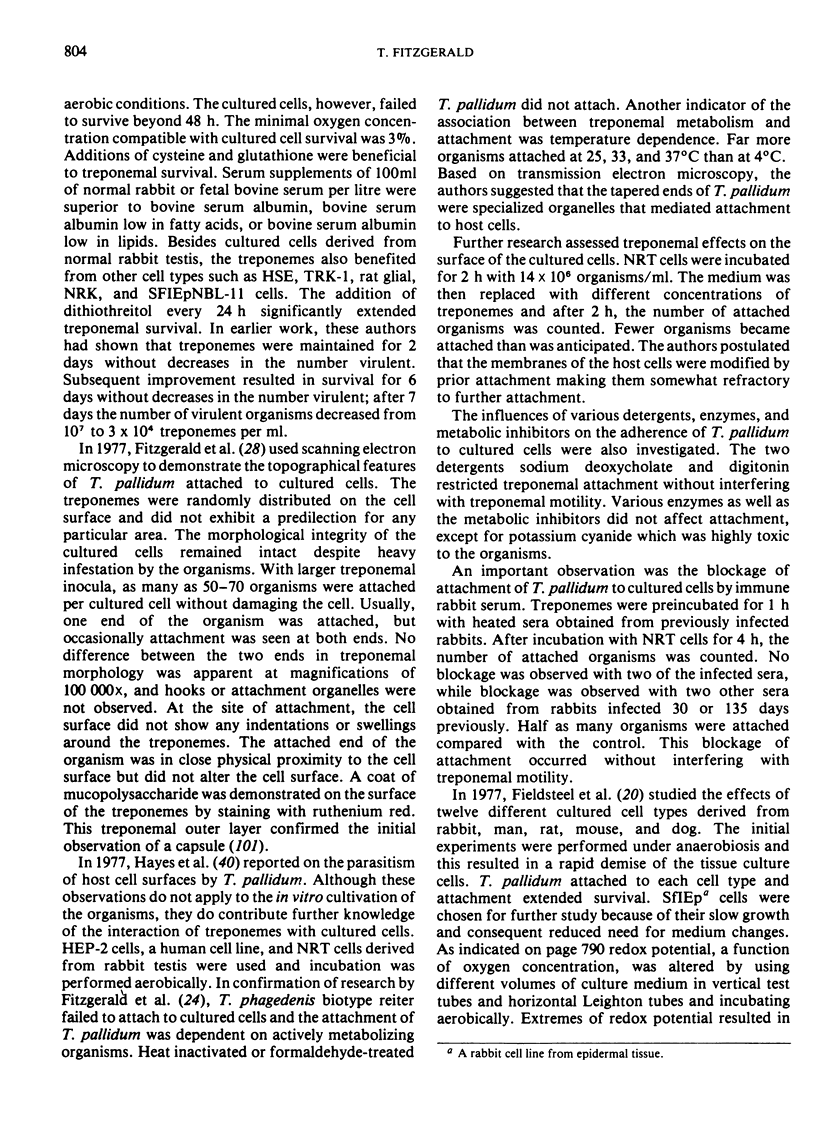
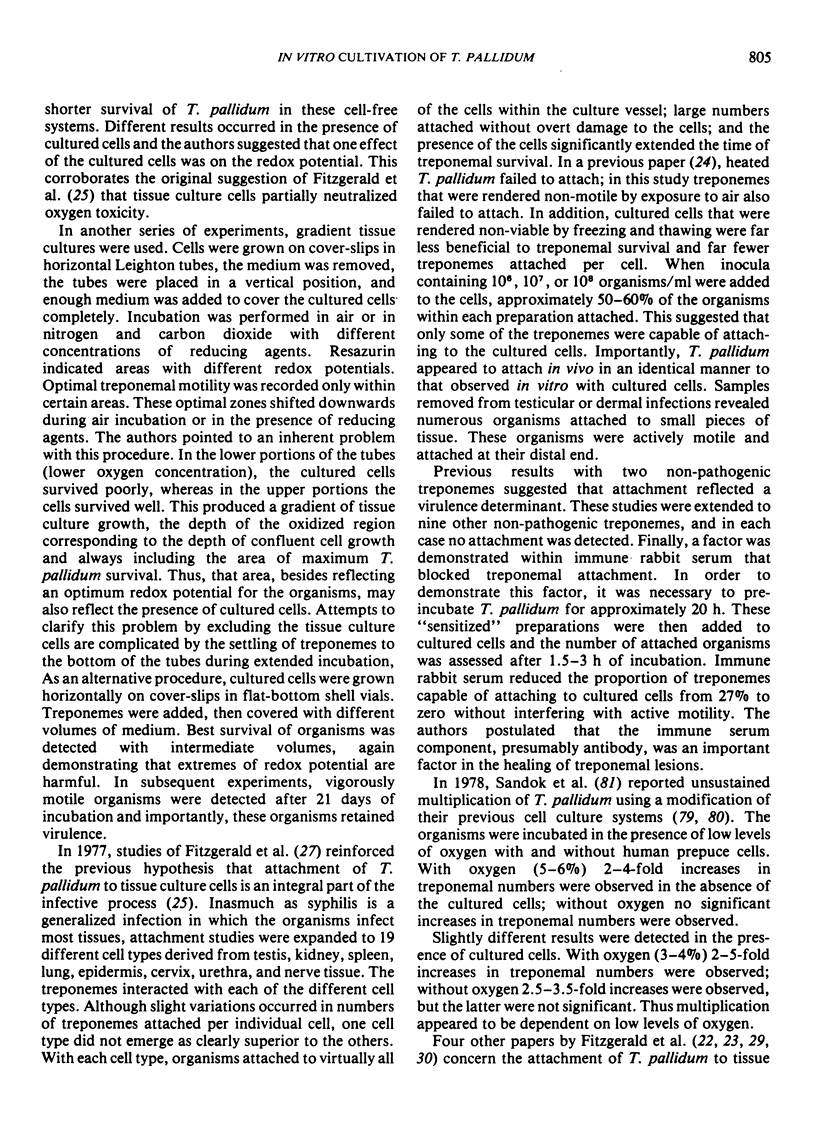
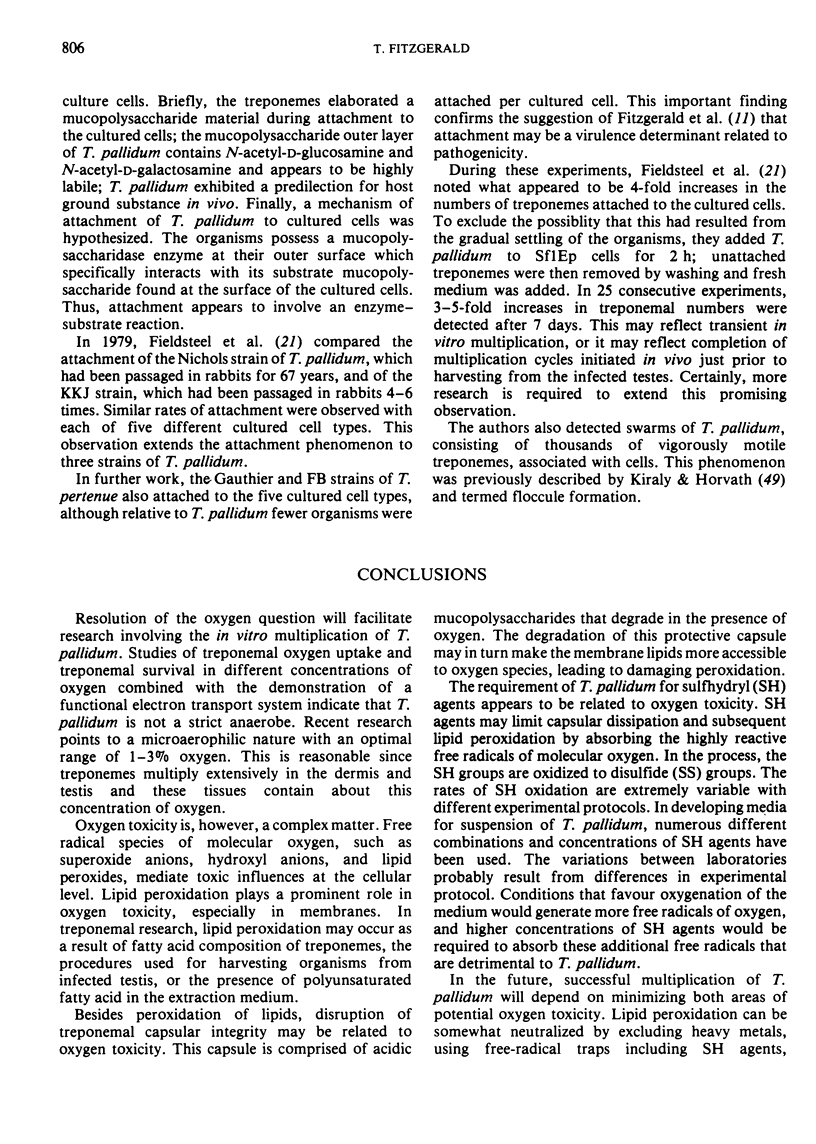
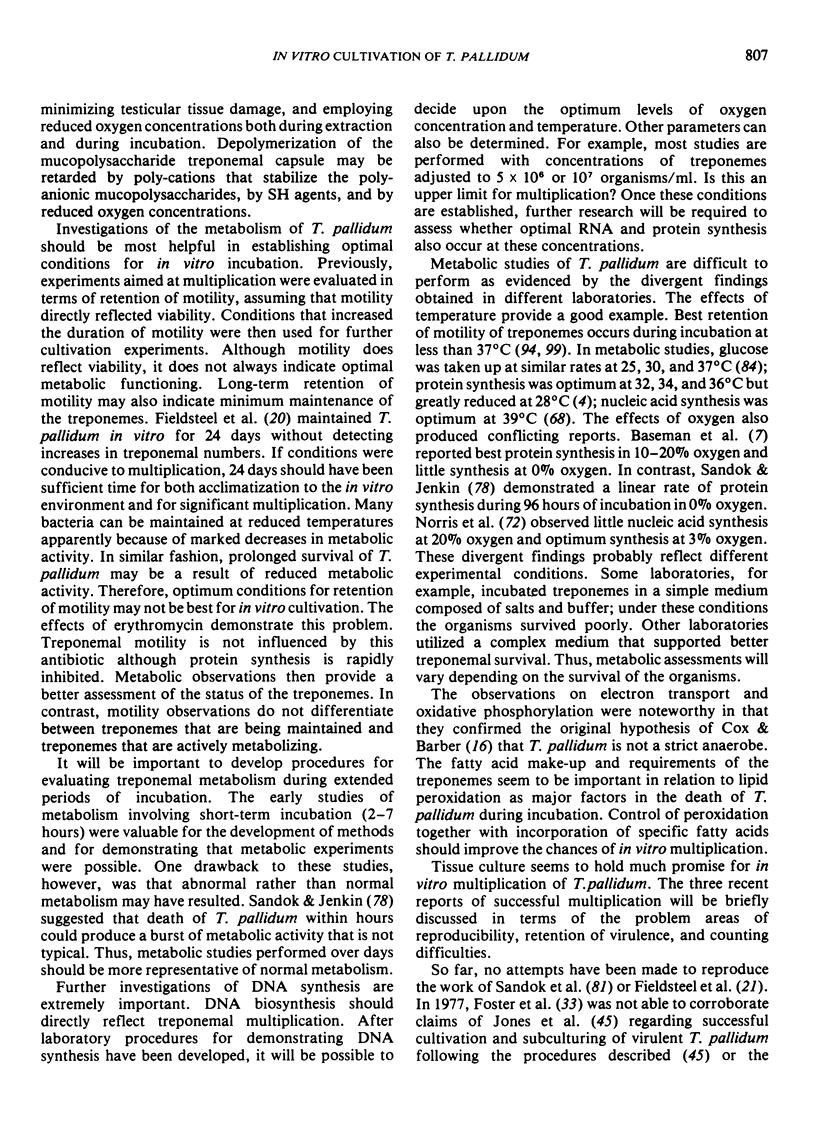
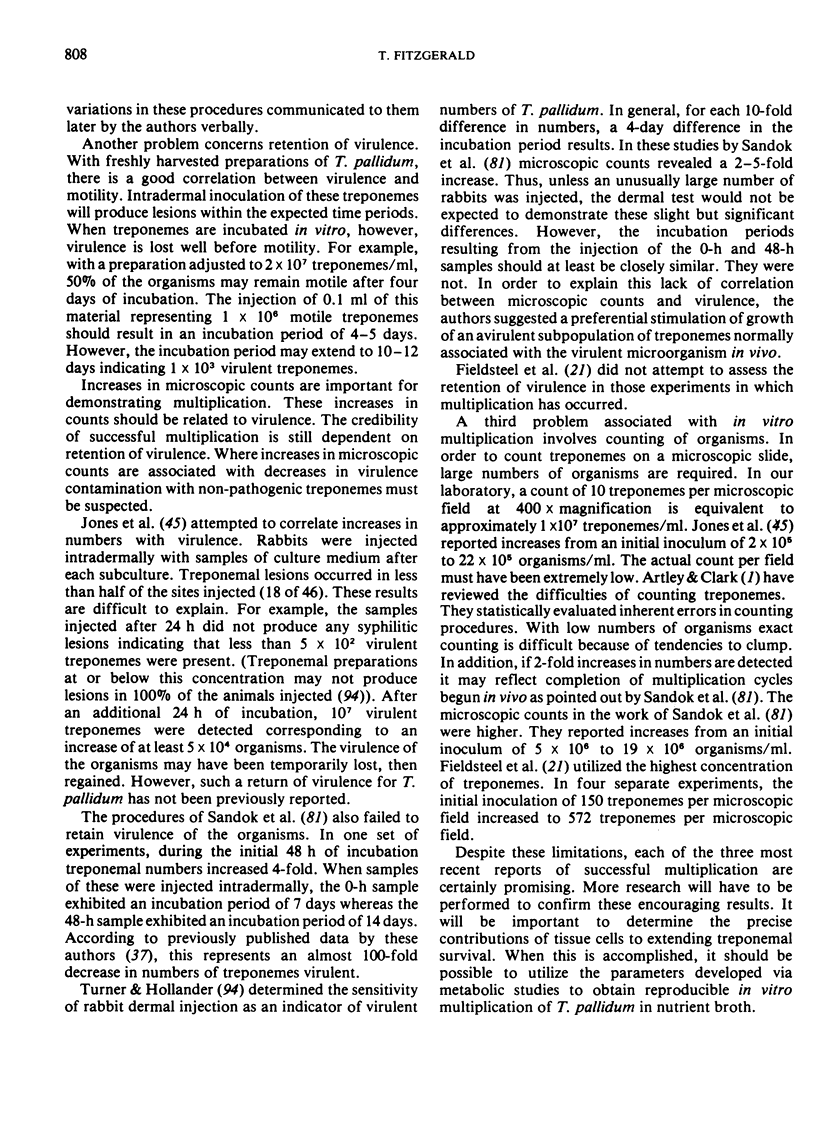
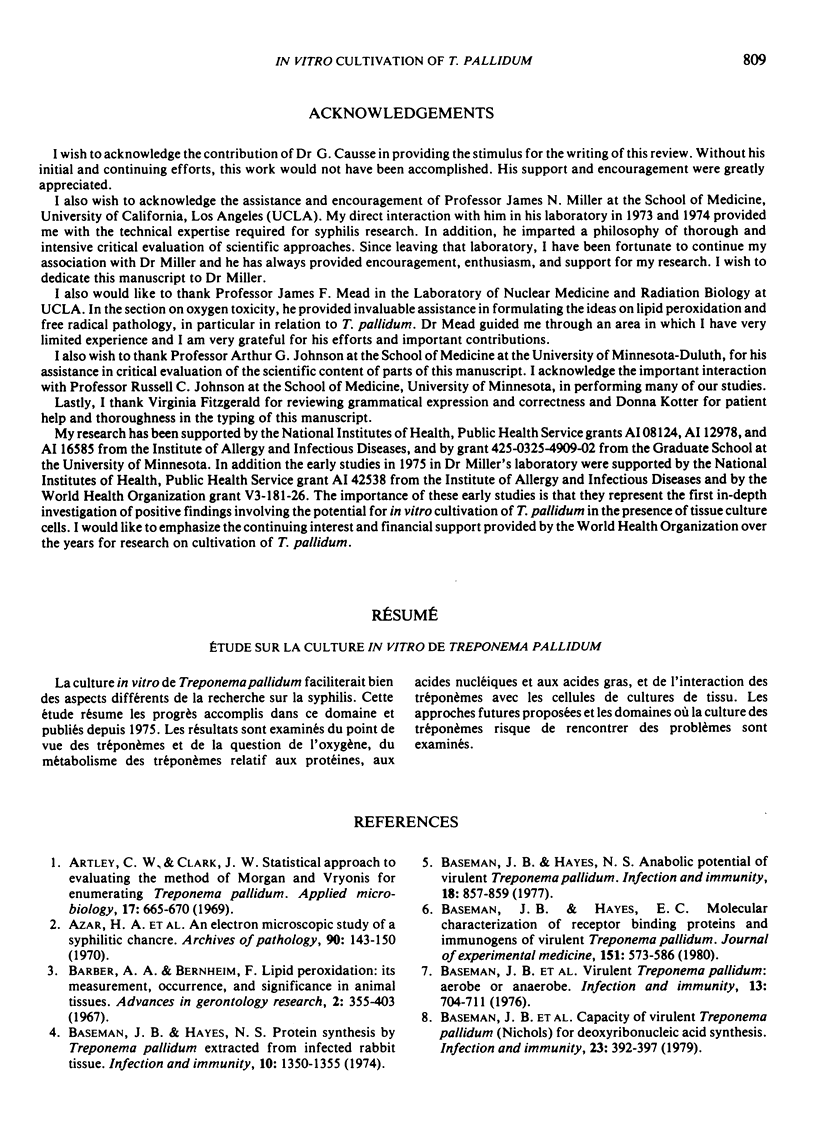
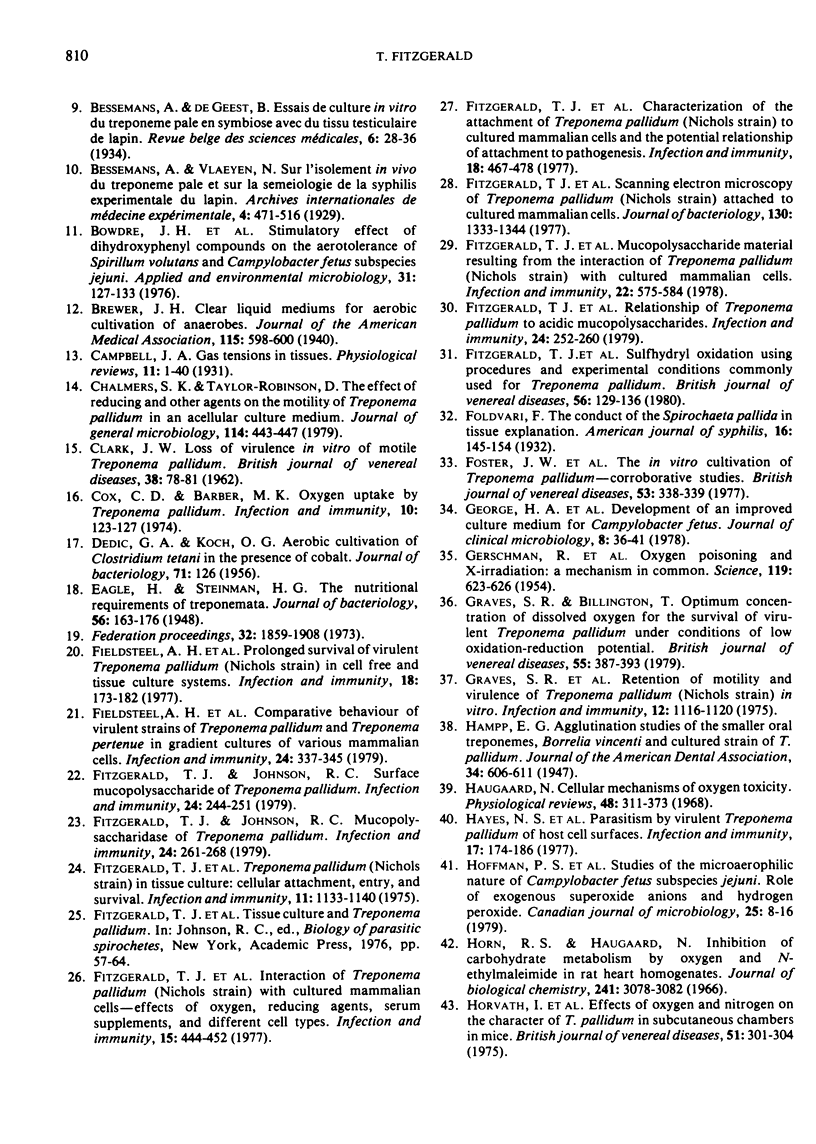
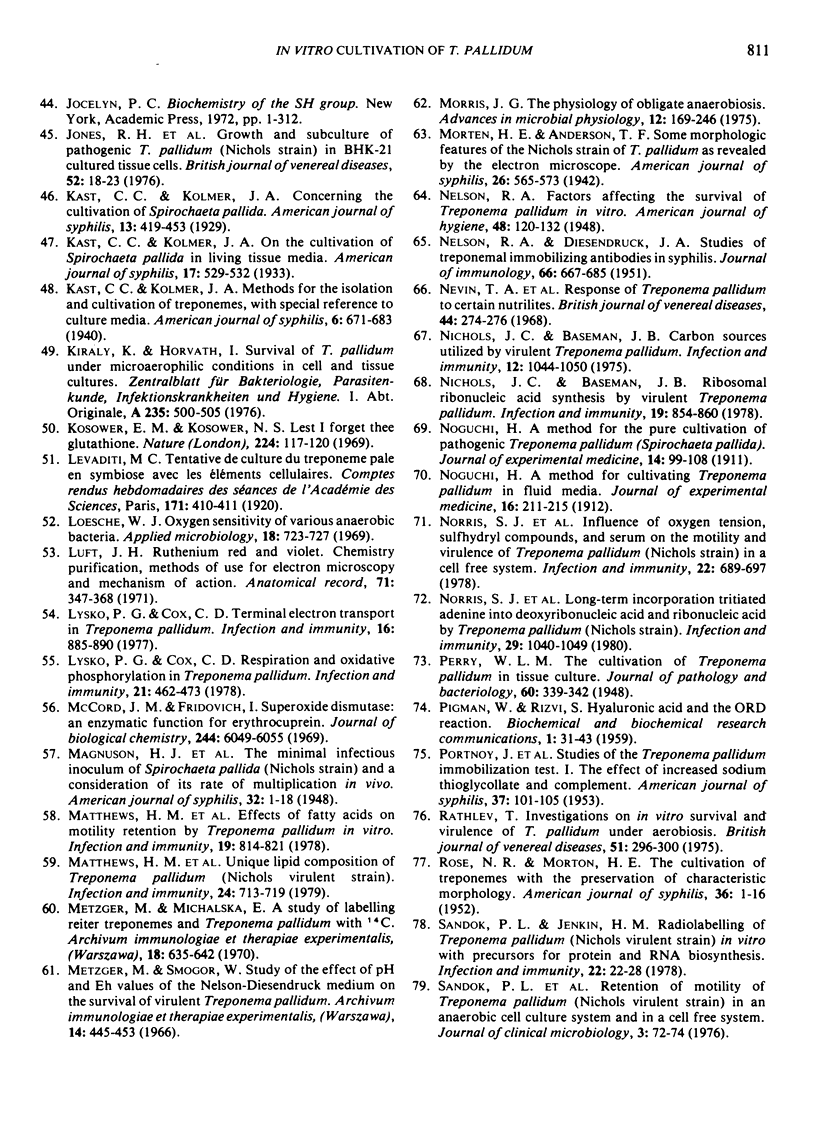
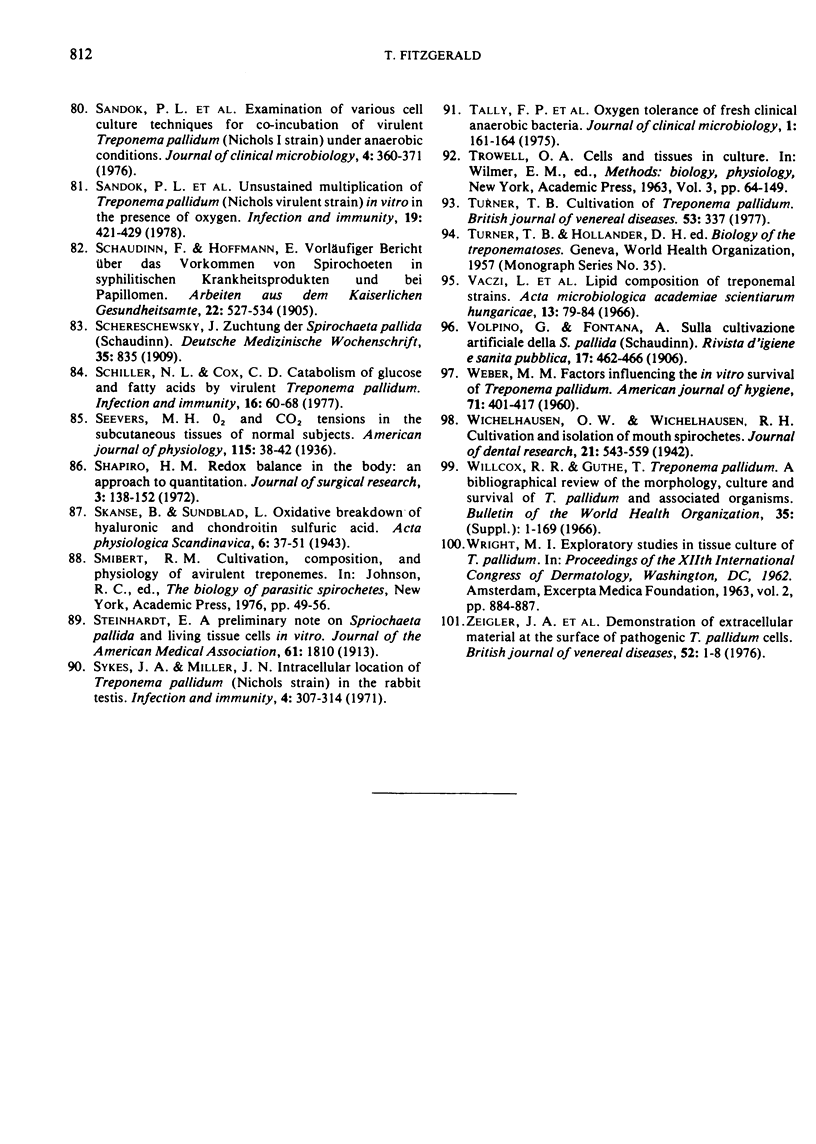
Selected References
These references are in PubMed. This may not be the complete list of references from this article.
- Artley C. W., Clark J. W., Jr Statistical approach to evaluating the method of Morgan and Vryonis for enumerating Treponema pallidum. Appl Microbiol. 1969 May;17(5):665–670. doi: 10.1128/am.17.5.665-670.1969. [DOI] [PMC free article] [PubMed] [Google Scholar]
- Azar H. A., Pham T. D., Kurban A. K. An electron microscopic study of a syphilitic chancre. Engulfment of Treponema pallidum by plasma cells. Arch Pathol. 1970 Aug;90(2):143–150. [PubMed] [Google Scholar]
- Barber A. A., Bernheim F. Lipid peroxidation: its measurement, occurrence, and significance in animal tissues. Adv Gerontol Res. 1967;2:355–403. [PubMed] [Google Scholar]
- Baseman J. B., Hayes E. C. Molecular characterization of receptor binding proteins and immunogens of virulent Treponema pallidum. J Exp Med. 1980 Mar 1;151(3):573–586. doi: 10.1084/jem.151.3.573. [DOI] [PMC free article] [PubMed] [Google Scholar]
- Baseman J. B., Hayes N. S. Anabolic potential of virulent Treponema pallidum. Infect Immun. 1977 Dec;18(3):857–859. doi: 10.1128/iai.18.3.857-859.1977. [DOI] [PMC free article] [PubMed] [Google Scholar]
- Baseman J. B., Hayes N. S. Protein synthesis by Treponema pallidum extracted from infected rabbit tissue. Infect Immun. 1974 Dec;10(6):1350–1355. doi: 10.1128/iai.10.6.1350-1355.1974. [DOI] [PMC free article] [PubMed] [Google Scholar]
- Baseman J. B., Nichols J. C., Hayes N. C. Virulent Treponema pallidum: aerobe or anaerobe. Infect Immun. 1976 Mar;13(3):704–711. doi: 10.1128/iai.13.3.704-711.1976. [DOI] [PMC free article] [PubMed] [Google Scholar]
- Baseman J. B., Nichols J. C., Mogerley S. Capacity of virulent Treponema pallidum (Nichols) for deoxyribonucleic acid synthesis. Infect Immun. 1979 Feb;23(2):392–397. doi: 10.1128/iai.23.2.392-397.1979. [DOI] [PMC free article] [PubMed] [Google Scholar]
- Bowdre J. H., Krieg N. R., Hoffman P. S., Smibert R. M. Stimulatory effect of dihydroxyphenyl compounds on the aerotolerance of Spirillum volutans and Campylobacter fetus subspecies jejuni. Appl Environ Microbiol. 1976 Jan;31(1):127–133. doi: 10.1128/aem.31.1.127-133.1976. [DOI] [PMC free article] [PubMed] [Google Scholar]
- CLARK J. W., Jr Loss of virulence in vitro of motile Treponema pallidum. Br J Vener Dis. 1962 Jun;38:78–81. doi: 10.1136/sti.38.2.78. [DOI] [PMC free article] [PubMed] [Google Scholar]
- Chalmers W. S., Taylor-Robinson D. The effect of reducing and other agents on the motility of Treponema pallidum in an acellular culture medium. J Gen Microbiol. 1979 Oct;114(2):443–447. doi: 10.1099/00221287-114-2-443. [DOI] [PubMed] [Google Scholar]
- Cox C. D., Barber M. K. Oxygen uptake by Treponema pallidum. Infect Immun. 1974 Jul;10(1):123–127. doi: 10.1128/iai.10.1.123-127.1974. [DOI] [PMC free article] [PubMed] [Google Scholar]
- DEDIC G. A., KOCH O. G. Aerobic cultivation of Clostridium tetani in the presence of cobalt. J Bacteriol. 1956 Jan;71(1):126–126. doi: 10.1128/jb.71.1.126-126.1956. [DOI] [PMC free article] [PubMed] [Google Scholar]
- Eagle H., Steinman H. G. The Nutritional Requirements of Treponemata: I. Arginine, Acetic Acid, Sulfur-containing Compounds, and Serum Albumin as Essential Growth-promoting Factors for the Reiter Treponeme. J Bacteriol. 1948 Aug;56(2):163–176. [PMC free article] [PubMed] [Google Scholar]
- Fieldsteel A. H., Becker F. A., Stout J. G. Prolonged survival of virulent Treponema pallidum (Nichols strain) in cell-free and tissue culture systems. Infect Immun. 1977 Oct;18(1):173–182. doi: 10.1128/iai.18.1.173-182.1977. [DOI] [PMC free article] [PubMed] [Google Scholar]
- Fieldsteel A. H., Stout J. G., Becker F. A. Comparative behavior of virulent strains of Treponema pallidum and Treponema pertenue in gradient cultures of various mammalian cells. Infect Immun. 1979 May;24(2):337–345. doi: 10.1128/iai.24.2.337-345.1979. [DOI] [PMC free article] [PubMed] [Google Scholar]
- Fitzgerald T. J., Cleveland P., Johnson R. C., Miller J. N., Sykes J. A. Scanning electron microscopy of Treponema pallidum (Nichols strain) attached to cultured mammalian cells. J Bacteriol. 1977 Jun;130(3):1333–1344. doi: 10.1128/jb.130.3.1333-1344.1977. [DOI] [PMC free article] [PubMed] [Google Scholar]
- Fitzgerald T. J., Johnson R. C., Miller J. N., Sykes J. A. Characterization of the attachment of Treponema pallidum (Nichols strain) to cultured mammalian cells and the potential relationship of attachment to pathogenicity. Infect Immun. 1977 Nov;18(2):467–478. doi: 10.1128/iai.18.2.467-478.1977. [DOI] [PMC free article] [PubMed] [Google Scholar]
- Fitzgerald T. J., Johnson R. C. Mucopolysaccharidase of Treponema pallidum. Infect Immun. 1979 Apr;24(1):261–268. doi: 10.1128/iai.24.1.261-268.1979. [DOI] [PMC free article] [PubMed] [Google Scholar]
- Fitzgerald T. J., Johnson R. C., Ritzi D. M. Relationship of Treponema pallidum to acidic mucopolysaccharides. Infect Immun. 1979 Apr;24(1):252–260. doi: 10.1128/iai.24.1.252-260.1979. [DOI] [PMC free article] [PubMed] [Google Scholar]
- Fitzgerald T. J., Johnson R. C. Surface mucopolysaccharides of Treponema pallidum. Infect Immun. 1979 Apr;24(1):244–251. doi: 10.1128/iai.24.1.244-251.1979. [DOI] [PMC free article] [PubMed] [Google Scholar]
- Fitzgerald T. J., Johnson R. C., Wolff E. T. Mucopolysaccharide material resulting from the interaction of Treponema pallidum (Nichols strain) with cultured mammalian cells. Infect Immun. 1978 Nov;22(2):575–584. doi: 10.1128/iai.22.2.575-584.1978. [DOI] [PMC free article] [PubMed] [Google Scholar]
- Fitzgerald T. J., Johnson R. C., Wolff E. T. Sulfhydryl oxidation using procedures and experimental conditions commonly used for Treponema pallidum. Br J Vener Dis. 1980 Jun;56(3):129–136. doi: 10.1136/sti.56.3.129. [DOI] [PMC free article] [PubMed] [Google Scholar]
- Fitzgerald T. J., Miller J. N., Sykes J. A. Treponema pallidum (Nichols strain) in tissue cultures: cellular attachment, entry, and survival. Infect Immun. 1975 May;11(5):1133–1140. doi: 10.1128/iai.11.5.1133-1140.1975. [DOI] [PMC free article] [PubMed] [Google Scholar]
- Foster J. W., Kellogg D. S., Clark J. W., Balows A. The in vitro cultivation of Treponema pallidum. Corroborative studies. Br J Vener Dis. 1977 Dec;53(6):338–339. doi: 10.1136/sti.53.6.338. [DOI] [PMC free article] [PubMed] [Google Scholar]
- GERSCHMAN R., GILBERT D. L., NYE S. W., DWYER P., FENN W. O. Oxygen poisoning and x-irradiation: a mechanism in common. Science. 1954 May 7;119(3097):623–626. doi: 10.1126/science.119.3097.623. [DOI] [PubMed] [Google Scholar]
- George H. A., Hoffman P. S., Smibert R. M., Krieg N. R. Improved media for growth and aerotolerance of Campylobacter fetus. J Clin Microbiol. 1978 Jul;8(1):36–41. doi: 10.1128/jcm.8.1.36-41.1978. [DOI] [PMC free article] [PubMed] [Google Scholar]
- Graves S. R., Sandok P. L., Jenkin H. M., Johnson R. C. Retention of motility and virulence of Treponema pallidum (Nichols strain) in vitro. Infect Immun. 1975 Nov;12(5):1116–1120. doi: 10.1128/iai.12.5.1116-1120.1975. [DOI] [PMC free article] [PubMed] [Google Scholar]
- Graves S., Billington T. Optimum concentration of dissolved oxygen for the survival of virulent Treponema pallidum under conditions of low oxidation-reduction potential. Br J Vener Dis. 1979 Dec;55(6):387–393. doi: 10.1136/sti.55.6.387. [DOI] [PMC free article] [PubMed] [Google Scholar]
- Haugaard N. Cellular mechanisms of oxygen toxicity. Physiol Rev. 1968 Apr;48(2):311–373. doi: 10.1152/physrev.1968.48.2.311. [DOI] [PubMed] [Google Scholar]
- Hayes N. S., Muse K. E., Collier A. M., Baseman J. B. Parasitism by virulent Treponema pallidum of host cell surfaces. Infect Immun. 1977 Jul;17(1):174–186. doi: 10.1128/iai.17.1.174-186.1977. [DOI] [PMC free article] [PubMed] [Google Scholar]
- Hoffman P. S., George H. A., Krieg N. R., Smibert R. M. Studies of the microaerophilic nature of Campylobacter fetus subsp. jejuni. II. Role of exogenous superoxide anions and hydrogen peroxide. Can J Microbiol. 1979 Jan;25(1):8–16. doi: 10.1139/m79-002. [DOI] [PubMed] [Google Scholar]
- Horn R. S., Haugaard N. Inhibition of carbohydrate metabolism by oxygen and N-ethylmaleimide in rat heart homogenates. J Biol Chem. 1966 Jul 10;241(13):3078–3082. [PubMed] [Google Scholar]
- Horvath I., Arko R. J., Bullard J. C. Effects of oxygen and nitrogen on the character of T. pallidum is subcutaneous chambers in mice. Br J Vener Dis. 1975 Oct;51(5):301–304. doi: 10.1136/sti.51.5.301. [DOI] [PMC free article] [PubMed] [Google Scholar]
- Jones R. H., Finn M. A., Thomas J. J., Folger C. Growth and subculture of pathogenic T. pallidum (Nichols strain) in BHK-21 cultured tissue cells. Br J Vener Dis. 1976 Feb;52(1):18–23. doi: 10.1136/sti.52.1.18. [DOI] [PMC free article] [PubMed] [Google Scholar]
- Király K., Horváth I. Survival of T. pallidum under microaerobic conditions in cell and tissue cultures. Zentralbl Bakteriol Orig A. 1976 Aug;235(4):500–505. [PubMed] [Google Scholar]
- Kosower E. M., Kosower N. S. Lest I forget thee, glutathione. Nature. 1969 Oct 11;224(5215):117–120. doi: 10.1038/224117a0. [DOI] [PubMed] [Google Scholar]
- Loesche W. J. Oxygen sensitivity of various anaerobic bacteria. Appl Microbiol. 1969 Nov;18(5):723–727. doi: 10.1128/am.18.5.723-727.1969. [DOI] [PMC free article] [PubMed] [Google Scholar]
- Lysko P. G., Cox C. D. Respiration and oxidative phosphorylation in Treponema pallidum. Infect Immun. 1978 Aug;21(2):462–473. doi: 10.1128/iai.21.2.462-473.1978. [DOI] [PMC free article] [PubMed] [Google Scholar]
- Lysko P. G., Cox C. D. Terminal electron transport in Treponema pallidum. Infect Immun. 1977 Jun;16(3):885–890. doi: 10.1128/iai.16.3.885-890.1977. [DOI] [PMC free article] [PubMed] [Google Scholar]
- Matthews H. M., Jenkin H. M., Crilly K., Sandok P. L. Effects of fatty acids on motility retention by Treponema pallidum in vitro. Infect Immun. 1978 Mar;19(3):814–821. doi: 10.1128/iai.19.3.814-821.1978. [DOI] [PMC free article] [PubMed] [Google Scholar]
- Matthews H. M., Yang T. K., Jenkin H. M. Unique lipid composition of Treponema pallidum (Nichols virulent strain). Infect Immun. 1979 Jun;24(3):713–719. doi: 10.1128/iai.24.3.713-719.1979. [DOI] [PMC free article] [PubMed] [Google Scholar]
- McCord J. M., Fridovich I. Superoxide dismutase. An enzymic function for erythrocuprein (hemocuprein). J Biol Chem. 1969 Nov 25;244(22):6049–6055. [PubMed] [Google Scholar]
- Metzger M., Michalska E. A study on labeling Reiter treponemes and Treponema pallidum with 14C. Arch Immunol Ther Exp (Warsz) 1970;18(6):635–642. [PubMed] [Google Scholar]
- Metzger M., Smogór W. Study of the effect of pH and Eh values of the Nelson-Diesendruck medium on the survival of virulent Treponema pallidum. Arch Immunol Ther Exp (Warsz) 1966;14(4):445–453. [PubMed] [Google Scholar]
- NELSON R. A., Jr, DIESENDRUCK J. A., ZHEUTLIN H. E. C., STACK P. S., BARNETT M. Studies on treponemal immobilizing antibodies in syphilis. I. Techniques of measurement and factors influencing immobilization. J Immunol. 1951 Jun;66(6):667–685. [PubMed] [Google Scholar]
- Nevin T. A., Guest W. J., Geller R. C. Response of Treponema pallidum to certain nutrilites. Br J Vener Dis. 1968 Dec;44(4):274–276. doi: 10.1136/sti.44.4.274. [DOI] [PMC free article] [PubMed] [Google Scholar]
- Nichols J. C., Baseman J. B. Carbon sources utilized by virulent Treponema pallidum. Infect Immun. 1975 Nov;12(5):1044–1050. doi: 10.1128/iai.12.5.1044-1050.1975. [DOI] [PMC free article] [PubMed] [Google Scholar]
- Nichols J. C., Baseman J. B. Ribosomal ribonucleic acid synthesis by virulent Treponema pallidum. Infect Immun. 1978 Mar;19(3):854–860. doi: 10.1128/iai.19.3.854-860.1978. [DOI] [PMC free article] [PubMed] [Google Scholar]
- Noguchi H. A METHOD FOR CULTIVATING TREPONEMA PALLIDUM IN FLUID MEDIA. J Exp Med. 1912 Aug 1;16(2):211–215. doi: 10.1084/jem.16.2.211. [DOI] [PMC free article] [PubMed] [Google Scholar]
- Noguchi H. METHOD FOR THE PURE CULTIVATION OF PATHOGENIC TREPONEMA PALLIDUM (SPIROCHAETA PALLIDA). J Exp Med. 1911 Aug 1;14(2):99–108. doi: 10.1084/jem.14.2.99. [DOI] [PMC free article] [PubMed] [Google Scholar]
- Norris S. J., Miller J. N., Sykes J. A., Fitzgerald T. J. Influence of oxygen tension, sulfhydryl compounds, and serum on the motility and virulence of Treponema pallidum (Nichols strain) in a cell-free system. Infect Immun. 1978 Dec;22(3):689–697. doi: 10.1128/iai.22.3.689-697.1978. [DOI] [PMC free article] [PubMed] [Google Scholar]
- Norris S. J., Miller J. N., Sykes J. A. Long-term incorporation of tritiated adenine into deoxyribonucleic acid and ribonucleic acid by Treponema pallidum (Nichols strain). Infect Immun. 1980 Sep;29(3):1040–1049. doi: 10.1128/iai.29.3.1040-1049.1980. [DOI] [PMC free article] [PubMed] [Google Scholar]
- PERRY W. L. M. The cultivation of Treponema pallidum in tissue culture. J Pathol Bacteriol. 1948 Apr;60(2):339–342. doi: 10.1002/path.1700600227. [DOI] [PubMed] [Google Scholar]
- PORTNOY J., HARRIS A., OLANSKY S. Studies of the Treponema pallidum immobilization test. I. The effect of increased sodium thioglycollate and complement. Am J Syph Gonorrhea Vener Dis. 1953 Mar;37(2):101–105. [PubMed] [Google Scholar]
- ROSE N. R., MORTON H. E. The cultivation of treponemes with the preservation of characteristic morphology. Am J Syph Gonorrhea Vener Dis. 1952 Jan;36(1):1–16. [PubMed] [Google Scholar]
- Rathlev T. Investigations on in vitro survival and virulence of T. pallidum under aerobiosis. Br J Vener Dis. 1975 Oct;51(5):296–300. doi: 10.1136/sti.51.5.296. [DOI] [PMC free article] [PubMed] [Google Scholar]
- Sandok P. L., Jenkin H. M., Graves S. R., Knight S. T. Retention of motility of Treponema pallidum (Nichols virulent strain) in an anaerobic cell culture system and in a cell-free system. J Clin Microbiol. 1976 Jan;3(1):72–74. doi: 10.1128/jcm.3.1.72-74.1976. [DOI] [PMC free article] [PubMed] [Google Scholar]
- Sandok P. L., Jenkin H. M., Matthews H. M., Roberts M. S. Unsustained multiplication of treponema pallidum (nichols virulent strain) in vitro in the presence of oxygen. Infect Immun. 1978 Feb;19(2):421–429. doi: 10.1128/iai.19.2.421-429.1978. [DOI] [PMC free article] [PubMed] [Google Scholar]
- Sandok P. L., Knight S. T., Jenkin H. M. Examination of various cell culture techniques for co-incubation of virulent Treponema pallidum (Nichols I strain) under anaerobic conditions. J Clin Microbiol. 1976 Oct;4(4):360–371. doi: 10.1128/jcm.4.4.360-371.1976. [DOI] [PMC free article] [PubMed] [Google Scholar]
- Schiller N. L., Cox C. D. Catabolism of glucose and fatty acids by virulent Treponema pallidum. Infect Immun. 1977 Apr;16(1):60–68. doi: 10.1128/iai.16.1.60-68.1977. [DOI] [PMC free article] [PubMed] [Google Scholar]
- Sykes J. A., Miller J. N. Intracellular location of Treponema pallidum (Nichols strain) in the rabbit testis. Infect Immun. 1971 Sep;4(3):307–314. doi: 10.1128/iai.4.3.307-314.1971. [DOI] [PMC free article] [PubMed] [Google Scholar]
- Tally F. P., Stewart P. R., Sutter V. L., Rosenblatt J. E. Oxygen tolerance of fresh clinical anaerobic bacteria. J Clin Microbiol. 1975 Feb;1(2):161–164. doi: 10.1128/jcm.1.2.161-164.1975. [DOI] [PMC free article] [PubMed] [Google Scholar]
- Turner T. B. Cultivation of Treponema pallidum. Br J Vener Dis. 1977 Dec;53(6):337–337. doi: 10.1136/sti.53.6.337. [DOI] [PMC free article] [PubMed] [Google Scholar]
- Váczi L., Király K., Réthy A. Lipid composition of treponemal strains. Acta Microbiol Acad Sci Hung. 1966;13(1):79–84. [PubMed] [Google Scholar]
- WEBER M. M. Factors influencing the in vitro survival of Treponema pallidum. Am J Hyg. 1960 May;71:401–417. doi: 10.1093/oxfordjournals.aje.a120123. [DOI] [PubMed] [Google Scholar]
- Willcox R. R., Guthe T. Treponema pallidum. A bibliographical review of the morphology, culture and survival of T. pallidum and associated organisms. Bull World Health Organ. 1966;35:1–169. [PMC free article] [PubMed] [Google Scholar]


